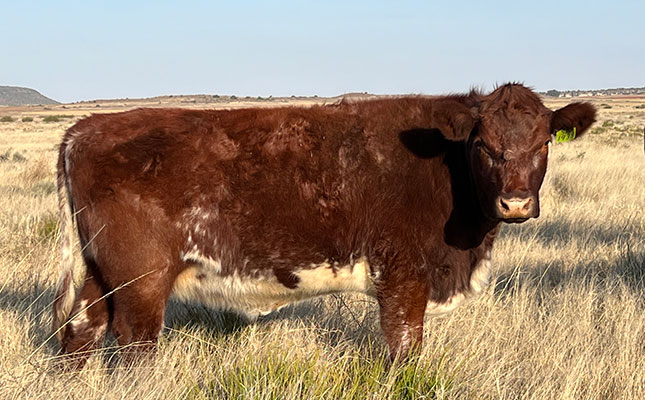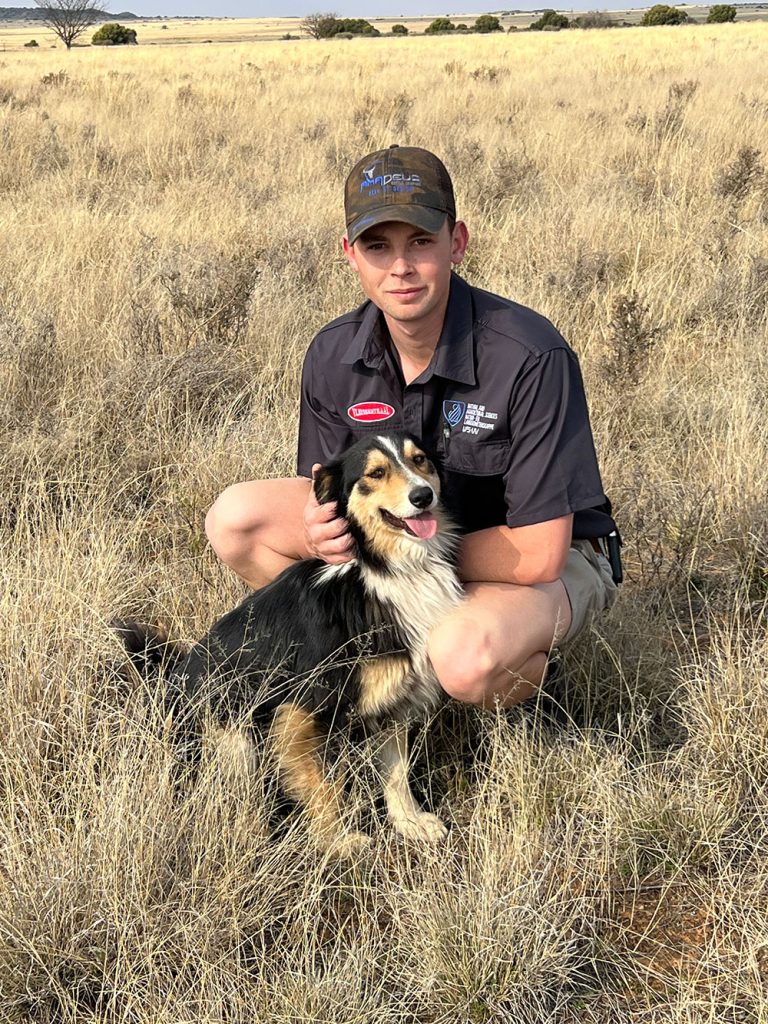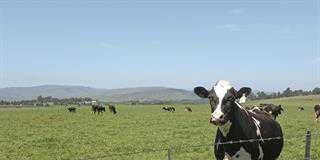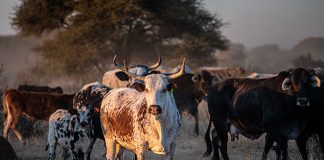
Photo: Amadeus Cattle Company
The first Beef Shorthorn was imported into South Africa in 1861, making it one of the oldest cattle breeds in the country, and the Shorthorn Cattle Breeders’ Society of South Africa was established in 1912.
The Stretton herd, formed in the 1860s, has long been one of the most prominent in the country, and Hendrik Strydom, owner of the Amadeus Cattle Company, has based his Beef Shorthorn herd primarily on Stretton genetics.
Shorthorns were originally bred as dual-purpose animals, used for both beef and milk. However, it was discovered that particular bloodlines were better for meat, while others were superior for milking. As a result, the lines eventually diverged to become the Beef and Milking Shorthorn breeds.
Hendrik and his sons Henco and Johann decided on the Beef Shorthorn for economic reasons after conducting extensive research on the breed, which is adapted to all of South Africa’s production regions, has excellent marbling traits, and crosses well with just about any other breed.
Two Shorthorn studs
The Strydoms have two Beef Shorthorn studs, namely the Amadeus stud in Petrusburg, Free State, and the Strydberg Farming stud in Molteno, Eastern Cape. Hendrik and Henco jointly own the Amadeus herd, while the Strydberg herd is part of a collaboration between five people, including Johann.
“We got an opportunity to rent land in Molteno, complete with a herd of Beef Shorthorn stud cows, on a long-term basis, and it was an opportunity we couldn’t miss. Since both of my sons are involved in farming, we had to look at a way to expand the business, and the Molteno opportunity allowed us to do just that,” explains Hendrik.

The Petrusburg herd is kept on mixed herbaceous shrubs with very good sweetveld. The carrying capacity varies between 1 LSU/10ha and 1 LSU/12ha, and the average annual rainfall is 420mm.
According to Hendrik, there is very little disease in the semi-arid Petrusburg area: “Over the past 25 years, I’ve had only one case of redwater.”
The carrying capacity on Molteno’s semi-sweetveld in the Stormberg is 1 LSU/6ha. There is also marshy land that provides excellent summer grazing. The area’s average annual rainfall is 500mm.
Economy and profitability
“We try not to exceed 75% of our carrying capacity. As livestock farmers, we’re first and foremost grass and grazing farmers. Responsible veld management forms the foundation of our business, and as stewards of the land, we’re responsible for keeping the veld in optimal condition in times of plenty and in times of want, such as a drought.
“Together, the two stud herds currently comprise 90 breeding cows, 30 heifers, four mature bulls, and three young bulls. The plan is to push this up to a total of 300 animals in the near future,” says Hendrik.
Before the addition of the Beef Shorthorns, the Strydoms ran a stud and a commercial herd of Dexters (and continue to do so). In 2013, they started looking for another breed to cross with the small-framed yet highly economical Dexters in order to increase production by pushing up weaning weights.
“It obviously had to be a breed with which we could make money. I spent countless hours looking for precisely the right breed until I was introduced to the Beef Shorthorn by Neil Dry, a stud breeder near Magaliesburg.
“He gave us a few semen straws, which we used on commercial Dexter cows. For us, it was the perfect combination,” explains Hendrik.
Proven breed
Henco showed Farmer’s Weekly a few Beef Shorthorn yearbooks from the 1920s. In those years, the Beef Shorthorn was the second-most popular cattle breed in South Africa after the Afrikaner. The breeders’ society had some 390 members, of which 196 ran stud concerns.
The fact that 52 composite breeds around the world, including the Beefmaster, Bonsmara and Santa Gertrudis, have Beef Shorthorn blood also swung the Strydoms’ decision in favour of the breed.
The first two Amadeus Beef Shorthorn cows came from Barry Stretton’s Brosterlea Shorthorn Stud in Molteno.
The Strydoms follow a very simple breeding policy: each cow is expected to drop and raise a marketable calf every year. Any cow that either fails to conceive during the breeding season or doesn’t raise a calf is culled.
Better than the best
“We don’t have room for passengers,” says Henco. “Since the Amadeus motto is ‘Be better than the best’, we implemented precision livestock farming principles and practices. Performance testing therefore forms an integral part of our business. It shows us where we’re going with our breeding policy and exposes challenges and successes. It’s an invaluable tool for determining the direction we need to follow to achieve optimal sustainability and profitability.
“My father has a saying that I fully agree with. According to him, farmers, and livestock producers in particular, must measure what they can’t see, and see what they can’t measure,” he adds.
Artificial insemination
The Strydoms synchronise both herds and use artificial insemination (AI) on all the cows and heifers. Afterwards, bulls are introduced to the herd for two heat cycles.
Hendrik and his sons believe that AI enables them to select and obtain the best possible genetics both locally and internationally to meet their specific demands for the Amadeus and Strydberg herds.
However, they also actively seek solid historic genetics from some of the original South African herds that can be introduced into their own herds and eventually to other herds in the country. The aim is to conserve the proven genetics that have played a vital role in the development of the broader South African beef cattle herd.
The Strydoms currently only use imported semen on 25% of their cows during breeding season, unless it is genetics from a bull that has already performed well in the herd.
The AI schedule is followed up with single bull mating for the cows that failed to conceive.
The calving season is kept as short as possible, and the objective is to complete calving within 60 days, as it makes management easier.
Selection
According to Johann, bull selection is of the utmost importance, as their genes determine the genetic progress of any herd.
“The genetics of a cow affect only one calf in the herd at a time, while those of a bull affect the progeny of all the cows he covers. When we choose bulls, we prefer curve-bender animals from solid dam lines.
“Over and above dropping and raising a top calf every year, temperament and conformation are extremely important in dam selection. In addition, cows that present with calving problems are removed from the herd without exception. These animals are a waste of time and money,” adds Johann.
Hendrik says that heifers are allowed to reach sexual maturity before they are considered for breeding, and the same selection criteria are applied to heifers as to cows.
He adds: “I’m probably going to step on toes with this statement, but if heifers have had calving difficulties, they were probably bred too young.”
Crossbreeding
Hendrik believes that there are probably very few, if any, other cattle breeds that can beat the Beef Shorthorn at crossbreeding. The Strydoms’ commercial farming concern consists of Dexter and Dexter-type cows. In the past, they used Angus, Hereford and Beef Shorthorn bulls on the Dexter cows, but now use the Beef Shorthorn bulls exclusively because of the excellent results they have achieved with the breed.
“The Beef Shorthorn-Dexter cross is highly compatible with our management model, as the calves grow incredibly well, are very hardy and adaptable, and produce top-quality meat. The weaners are rounded off comfortably on veld because the Dexter and the Beef Shorthorn are both remarkably non-selective grazers.
“The Beef Shorthorn’s first-class growth rate is evident in the fact that the average weaning weight of our crossbred weaners is 224kg,” explains Hendrik.
Nutrition
Protein and phosphate licks are supplied in winter and summer respectively. The heifers and bulls also have access to a production lick all year round, and all the licks are combined with rock salt. Balanced and sufficient feed is a cornerstone of the Amadeus Cattle Company, and animals are never allowed to suffer from poor or inadequate nutrition.
The cows are divided into herds of 35 to 40 animals per camp in a rotation system, which gives them access to grass camps in summer, and more wooded ones in winter.
Calving ease
The Strydoms are not overly concerned with birthweights because, as Johann puts it, these weights have a lot to do with the type of grazing the mothers are kept on in their final two months of gestation. On good grazing, calves will obviously be somewhat heavier than those born from cows kept on poorer veld. Over the past three years, the average birthweights for Amadeus heifers and bulls were 36kg and 39kg respectively.
For the Strydoms, it is more important for dams to have the right conformation so that they can safely and easily drop heavier calves. An intercalving period of 350 to 380 days is maintained. Johann again stresses the importance of calving on a regular basis, and says that a cow that fails to produce a strong calf simply costs too much to keep.
Weaning weights are largely dependent on climatic conditions. The Strydoms received good rainfall over the past two years, allowing their heifers to wean at an average weight of 254kg, and their bull calves at an average weight of 265kg. Their dams had an average weight of 510kg.
A comprehensive vaccination programme has been implemented for the prevailing diseases in the western Free State, and the cattle are vaccinated every year between August and September. As a result, the cows transfer immunity to their calves when they start calving in November. The herd is treated for ectoparasites as needed.
Biosecurity and traceability
Biosecurity is vital to the Strydoms. The cattle are tested for brucellosis and the bulls for venereal diseases annually. New arrivals are quarantined and tested for diseases before being introduced to the existing herds. Animals are also quarantined for 30 days after shows before returning to the herds.
“We’re serious about livestock traceability,” says Johann. “We’re currently involved in the development and testing of ID-Scan, a smartphone app that allows a breeder to scan the cattle’s noses, which are all unique, much like human fingerprints. This allows for the identification of individual animals as part of a traceability and tracking system.
“The app also allows for the recording of each animal’s vaccination and treatment history.”
Email Hendrik Strydom at [email protected].











